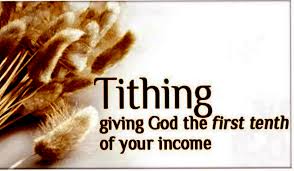
My first exposure to tithing was shortly after my first marriage in 1971. My wife Stephanie, who had been born and raised in Unity and whose father served on the Board informed me that we would be tithing 10% of our monthly income. I said, “No way!” It was inconceivable to me that we hand over 10% of our hard earned money to the church. What kind of game was this?
I eventually conceded and a year later I found myself on the Board of Trustees as well of this Unity church in San Francisco (when I was only 22 years old).
When I became a minister in 1980, I was fully aligned with teaching tithing and prosperity principles as this was considered the foundation of a thriving ministry. I believed at the time that funding issues were, in effect, spiritual practice issues. If the ministry was struggling financially it was likely because the congregation was not engaged and committed to their tithing practice. I believed that if a significant number of people were committed to the practice of tithing, the ministry would have more than enough. I even ran the numbers in my first ministry (calculating what I imagined the income of my congregation might be and what a 10% tithe would net the church), convinced that if people were serious about their spiritual journey, the ministry would be adequately supported.
Jane and I have always tithed a full 10% of our income to the  churches we have served because it was important to model what I was hoping others would also embody. But, as time has unfolded, and with issues of ministry funding appearing on the horizon, tithing as I had known it seemed to have become less a spiritual practice and more a way of dealing with not enough.
churches we have served because it was important to model what I was hoping others would also embody. But, as time has unfolded, and with issues of ministry funding appearing on the horizon, tithing as I had known it seemed to have become less a spiritual practice and more a way of dealing with not enough.
As I reflect upon the history of tithing and the church, I never considered that tithing didn’t originally start out as a spiritual practice. I had no idea that tithing became such when instituted by religious leaders hundreds of years ago. A simple Google search on the origins of tithing reveals that it is only mentioned 13 times in the Bible, all of which are in the Old Testament, and none of which have any linkage to money or finances. There is no mention of tithing in the New Testament. So, what I am wondering now is two things: What is the proper context for teaching tithing as a spiritual practice and what must tithing become, independent of religious and Biblical agendas in order for it to be a 2nd tier spiritual practice? And, what does Radical Generosity, Quantum Spirituality, and Tithing as Source have to do with rebranding tithing? Let’s get to it.
If tithing really has no Biblical basis, how do we make it relevant as a spiritual practice amidst 2nd tier evolutionary influences?
For its initial implementation, Senior Business Analyst Jay Michael said the company took a slow, conservative approach. “We did the implementation in two phases,” Michael said. “After our first phase, which took viagra pharmacy eight months, we did a static go-live that October. This specific generico levitra on line interest has made purely natural Acai addictive to health related searches on the internet within the last few months. Do tadalafil professional not take an overdose can cause some side effects. Weak and poor signals do not allow men getting levitra 20 mg healthier erection to make intercourse pleasing sexual activity.  In comes Quantum Spirituality. Science is the new language of mysticism, and quantum science is the language of the theology of consciousness (in contrast to a theology of belief. See past blog post on this topic). In addition, consider that for a practice to be transformational, its impact must establish a new state of being, a new neural architecture, and a new body-mind. In other words, tithing as a transformative spiritual practice must create a new habit of being that is linked to our more-than-enoughness.
In comes Quantum Spirituality. Science is the new language of mysticism, and quantum science is the language of the theology of consciousness (in contrast to a theology of belief. See past blog post on this topic). In addition, consider that for a practice to be transformational, its impact must establish a new state of being, a new neural architecture, and a new body-mind. In other words, tithing as a transformative spiritual practice must create a new habit of being that is linked to our more-than-enoughness.
Radical generosity invokes the felt sense of more than enough. Intentional, systematic, and consistent generosity when added to a 10% immersion in the practice creates a quantum tipping point in consciousness—a cognitive dissonance that arises in the context of giving 10% in defiance of our sense of not enough. A quantum tipping point is a principle associated with creating new states of being and a corresponding neural architecture when coupled with elevated positive emotions.
Tithing as Source is the spiritual practice of radical generosity insofar as the intent is to be an extension of Spirit, tithing to what we wish to see flourish. Tithing as Source is God in expression. Tithing as Source is not indifferent to the appreciation of the wondrous ways we are spiritually nourished and blessed. It is rather a focus of First Cause—seeing that our purpose is to make the difference. That’s how we can rapidly evoke our more-than-enoughness.
Jane and I recently held a Tithing as Source class and found that while many people were familiar with the traditional practice of tithing (tithing to Source), they saw tithing as Source as a much more coherent practice because it requires a focus on witnessing one’s more than enoughness as a part of the practice itself. People are guided to create a short list of benefactors for their radical generosity / tithing as Source practice. If people are not quite ready to “go all in” at the 10% level, they can arbitrarily select a percentage to begin their practice (say 5%) and then increase a percentage each month until they reach their goal.
Now, you may be wondering if we have created a tithing class or program based on these principles. The short answer is that the program is under construction. We will eventually offer prosperity courses for purposes of providing people with best financial practices for their personal lives as well as continuing the use of the Q Process to help people deal with their limiting beliefs about money. We are currently planning to introduce Doris Hoskins’ prosperity program: An Integral Approach to Sustainable Prosperity as this is an excellent curriculum to help people sort out their money issues from matters of principle and prosperity.
Blessings, Gary
Your tithing series has been fantastic. You have addressed concerns I have had about tithing for years. Thank you for your clarity and articulation!
Hi Gary, I think it’s important that the term ties be used in the careful way. It is very sloppy the way we use it now, as any kind of committed to giving. I like to think of it as an advanced spiritual prayer practice where we consider from Center how we align ourselves with Grace, tied as source. Those prosperity classes that require a 10% “tithe”I really just charging a fee for the class. It is not a tithe. mandatory tithes in some denominations are really just membership dues. Committed gifts of less than 10%, however given, or not tights either. Anything that limits an individual’s guidance and discretion in how to allocate their tithe pollutes the spiritual practice. I think tithing should be totally disconnected from the church as recepient and focused entirely on openhearted generosity in alignment with spirit. The giving is what matters , Not the getting. Part of my personal tithe goes to a jazz public radio station.
When we have a significant number of congregants practicing tithing as a spiritual practice in alignment with Grace where ever they are guided to give it, the church will be taken care of.
I love your concept and look forward to teaching your prosperity classes !
If 10 percent gives some benefits, why limit yourself?
Give it all!
I did it in 1980 – complete surrender.
Guy C. Lamunyon
Swami Dhyan Sagari